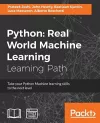
Python: Real World Machine Learning
5 authors - Paperback
£70.99
Prateek Joshi is a Computer Vision researcher and published author. He has over eight years of experience in this field with a primary focus on content-based analysis and deep learning. His work in this field has resulted in multiple patents, tech demos, and research papers at major IEEE conferences. He is the author of OpenCV with Python By Example, Packt Publishing. He has won many hackathons using a wide variety of technologies related to image recognition. His blog has been visited by users in more than 200 countries, and he has been featured as a guest author in prominent tech magazines. He enjoys blogging on topics, such as artificial intelligence, abstract mathematics, and cryptography. You can visit his blog at www.prateekvjoshi.com. He is an avid coder who is passionate about building game-changing products. He is particularly interested in intelligent algorithms that can automatically understand the content to produce scene descriptions in terms of constituent objects. He graduated from the University of Southern California and has worked for such companies as Nvidia, Microsoft Research, Qualcomm, and a couple of early stage start-ups in Silicon Valley. You can learn more about him on his personal website at www.prateekj.com. David Millan Escriva was eight years old when he wrote his first program on an 8086 PC with BASIC language, which enabled the 2D plotting of BASIC equations. He started with his computer development relationship and created many applications and games. In 2005, he completed his studies in IT from the Universitat Politecnica de Valencia with honors in human-computer interaction supported by Computer Vision with OpenCV (v0.96). He had a final project based on this subject and published it on HCI Spanish Congress. In 2014, he completed his Master's degree in artificial intelligence, computer graphics, and pattern recognition, focusing on pattern recognition and Computer Vision. He participated in Blender source code, an open source and 3D-software project, and worked in his first commercial movie, Plumiferos—Aventuras voladoras, as a computer graphics software developer. David now has more than 13 years of experience in IT, with more than nine years of experience in Computer Vision, computer graphics, and pattern recognition, working on different projects and start-ups, applying his knowledge of Computer Vision, optical character recognition, and augmented reality. He is the author of the DamilesBlog (http://blog.damiles.com), where he publishes research articles and tutorials on OpenCV, Computer Vision in general, and optical character recognition algorithms. He is the co-author of Mastering OpenCV with Practical Computer Vision Projects Book and also the reviewer of GnuPlot Cookbook by Lee Phillips, OpenCV Computer Vision with Python by Joseph Howse, Instant Opencv Starter by Jayneil Dalal and Sohil Patel, all published by Packt Publishing. Vinicius Godoy is a computer graphics university professor at PUCPR. He started programming with C++ 18 years ago and ventured into the field of computer gaming and computer graphics 10 years ago. His former experience also includes working as an IT manager in document processing applications in Sinax, a company that focuses in BPM and ECM activities, building games and applications for Positivo Informatica, including building an augmented reality educational game exposed at CEBIT and network libraries for Siemens Enterprise Communications (Unify). As part of his Master's degree research, he used Kinect, OpenNI, and OpenCV to recognize Brazilian sign language gestures. He is currently working with medical imaging systems for his PhD thesis. He was also a reviewer of the OpenNI Cookbook, Packt Publishing. He is also a game development fan, having a popular site entirely dedicated to the field called Ponto V (http://www.pontov.com.br). He is the cofounder of a startup company called Blackmuppet. His fields of interest includes image processing, Computer Vision, design patterns, and multithreaded applications.